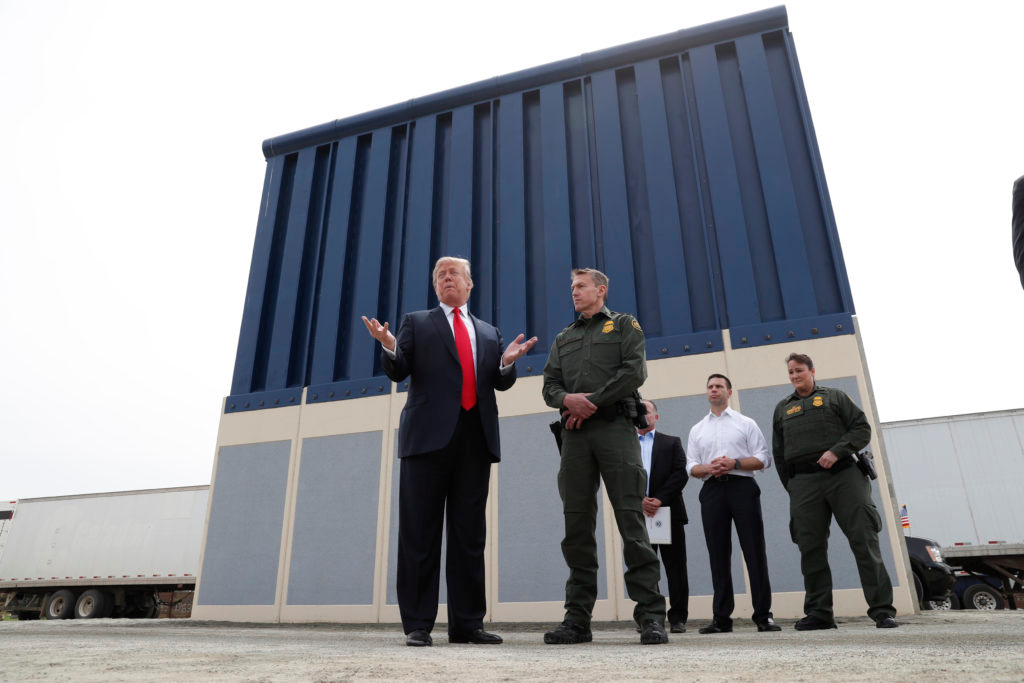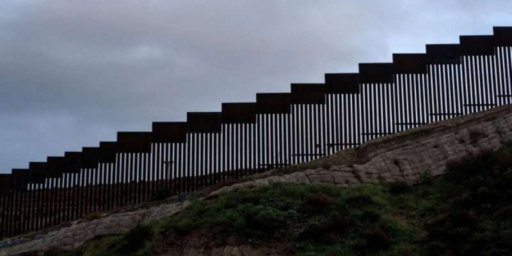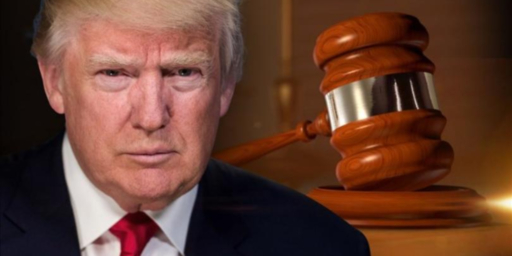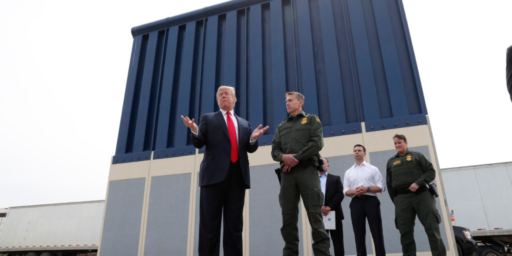Judge Orders Halt To Trump’s ‘National Emergency’ Border Wall Funding
A Federal Judge has put at least a partial hold on President's Trump's effort to use a "national emergency" to fund his border wall.

A Federal District Court Judge in Texas has ordered a halt to the President’s plan to use Pentagon funds to build part of his border wall, a plan implemented after the President declared a “national emergency” at the southern border in a bid to get around Congress’s refusal to approve funding in the current budget:
LOS ANGELES — President Trump’s efforts to build a wall along the southwest border hit a roadblock on Friday night when a federal judge in California granted a preliminary injunction that prevents the administration from redirecting funds under the national emergency declaration issued in February.
The judge, Haywood Gilliam of the United States District Court for the Northern District of California, who is overseeing a pair of lawsuits over border wall financing, ruled that the administration’s efforts likely overstep the president’s statutory authority.
The injunction applies specifically to some of the money the administration intended to allocate from other agencies, and it limits wall construction projects in El Paso, Tex., and Yuma, Ariz.
The ruling quoted from a Fox News interview with Mick Mulvaney, the acting White House chief of staff, in which he said that the wall “is going to get built, with or without Congress.”
The idea that the president can act “without Congress” when lawmakers refuse a funding request from the White House “does not square with fundamental separation of powers principles dating back to the earliest days of our Republic,” Judge Gilliam wrote.
The White House did not immediately respond to a request for comment.
The two related cases were argued before Judge Gilliam, who was appointed by President Barack Obama, earlier this month — one filed by the State of California in conjunction with 19 other states, and a second from the American Civil Liberties Union on behalf of the Sierra Club and the Southern Border Communities Coalition.
Both suits argued that Mr. Trump had overstepped his constitutional authority by using money to fund a border barrier without congressional approval. The legal challenges were filed shortly after President Trump declared a national emergency along the Mexican border. The move by the president followed a two-month standoff with Congress over funding to build his long-promised barrier wall.
That impasse led to a partial government shutdown in December and January, and lawmakers ultimately denied the border funding he had requested.
Mr. Trump had sought $5.7 billion to finance a steel wall along more than 200 miles of the border; Congress instead appropriated about $1.4 billion for fencing that would cover 55 miles. Unhappy with the outcome, Mr.
Trump remained intent on funding the wall with or without congressional appropriations.
“One of the things I said I have to do and I want to do is border security, because we have tremendous amounts of drugs flowing into our country, much of it coming from the southern border,” he said when he announced his emergency declaration. “We’re going to confront the national security crisis on our southern border, and we’re going to do it one way or the other.”
White House officials said in a memo that the administration would redirect $601 million from the Treasury’s forfeiture fund, up to $2.5 billion from Department of Defense funds allocated to counter drug activity, and up to $3.6 billion from Department of Defense capital projects.
But the president’s critics objected that such action was not allowed by law. Congress, they said, was granted control over the country’s finances by the Constitution.
More from The Washington Post:
A federal judge has temporarily blocked part of President Trump’s plan to build a wall along the southern border with money Congress never appropriated for that purpose.
U.S. District Judge Haywood S. Gilliam Jr., of the Northern District of California, said that those challenging Trump’s actions had a good chance of prevailing on their claims that the administration is acting illegally in shifting money from other programs to pay for the wall.
Gilliam wrote that the government’s position “that when Congress declines the Executive’s request to appropriate funds, the Executive may simply find a way to spend those funds ‘without Congress’ does not square with fundamental separation of powers principles dating back to the earliest days of our Republic.”
The law the administration invoked to shift funds allows transfers for “unforeseen” events. Gilliam said the government’s claim that wall construction was “unforeseen” “cannot logically be squared” with Trump’s many demands for funding dating back to early 2018 and even in the campaign.
With some contracts already awarded for construction, Gilliam said that allowing work to go forward before the legal issues have been fully resolved could cause irreparable harm.
He ruled in response to lawsuits brought by the Sierra Club and the Southern Border Communities Coalition.
The plaintiffs sought preliminary injunctions against the administration’s diversion of billions of dollars meant for other purposes. The plaintiffs alleged that Trump’s actions violate the constitutional requirement that no money may be spent without an appropriation from Congress as well as legal restrictions on the purposes for which funds can be reallocated.
The suits asked Gilliam to block any wall-related activity paid for with those funds while he fully considers the merits of the suits.
About $1 billion has been moved from military pay and pension accounts, transfers that Gilliam ruled against Friday, but no money has been transferred from the emergency military construction fund for which the president declared a state of emergency in February. That fund represents about $3.6 billion of the money President Trump wants to use.
Gilliam said he would rule on that issue separately when the administration actually shifts money using that authority. He doubted the administration would prevail on that, either, questioning whether a border fence met the definition of “military construction,” an interpretation that would give the government “unbounded authority” not authorized by law, he said.
The Justice Department did not respond to requests for comment late Friday.
A lawyer for the American Civil Liberties Union, Dror Ladin, who argued the plaintiffs’ case, called the order “a win for our system of checks and balances, the rule of law and border communities.”
Friday’s order applies to wall segments around Yuma and El Paso. Sanjay Narayan, Sierra Club managing attorney, said additional segments announced too late for Friday’s decision will be taken up in early June.
The Sierra Club lawsuit, in which the group is represented by the American Civil Liberties Union, was combined with other cases also pending before the same court, but the outcome was far different in one of those cases, In a case filed by California and other states, Judge Gilliam, who was appointed to the bench by President Obama in 2014, did not issue an injunction Instead, he dealt the states a setback in that they had failed to show the “irreparable harm” required for the entry of such an order. This does not mean that the state-based case is over, but it does not bode well for the future of that case as it moves further down the litigation track. Nonetheless, the fact that an injunction has been issued in the Sierra Club case provides most, if not all, of the relief that the states were seeking in their own lawsuit. In addition to these cases, there are also pending cases resulting from lawsuits brought by the Center for Biological Diversity, Defenders and Wildlife, and the Animal Defense Fund as well as other another case filed by the watchdog group Public Citizen on behalf of Texas landowners and an environmental group in Texas. There have not been any rulings in those cases issued as of this date.
All of this, of course, is rooted in the “national emergency” that President Trump declared in late February at the same time that he signed off on the budget deal reached by the House and Senate. That deal, of course, did not include significant funding for the President’s border wall, something that had been the main issue of contention during the thirty-five-day government shutdown that lasted from December 22nd to January 25th. The President declared this emergency by relying on the authority granted to him under the National Emergencies Act of 1976, which has been used by Presidents in the past but never in the manner that Trump used it to provide funding to a project that had been specifically denied by Congress. Indeed, the President seemed to undermine his own case for a “national emergency” at the news conference where he announced it when he admitted that he “did not need to do this.” Specifically, the President admitted that he could have waited for additional funding from Congress but that he wanted to speed the project along. This admission is an obviously damaging admission on the part of the President because it suggests that there is no “national emergency” and that Trump was merely using the alleged authority the law provides to him to get around the political process that the Constitution contemplates.
In addition to these rulings, Congress also sought to block the President’s declaration of a “national emergency” through the procedures allowed by the 1976 law. Within days after the President had made his declaration, the Democratic-controlled House of Representatives began considering a resolution designed to halt that declaration. That resolution was approved by the House and Senate but vetoed by the President, and Congress unsurprisingly failed to override that veto. Despite that veto, though, it was notable that at least in the Senate the vote against the President’s declaration was bipartisan in some sense, with six Republicans joining in with the Democrats in favor of the resolution. Unfortunately, the number of Republicans in the House who did the same as relatively small.
In his ruling, Judge Gilliam relied on the President’s aforementioned admission that the declaration of a “national emergency” was unnecessary, as well as other facts and circumstances surrounding the President’s declaration of a “national emergency.” Based on this, he determined that the President had acted beyond the scope of the authority allowed to him by the law. The ruling is significant in that, in the past, courts had only given cursory examination to the justification for a President’s declaration of an emergency, a position that of course gave the Chief Executive wide latitude in both determining when a “national emergency” exists and what the law authorizes him to do after declaring such an emergency. If this part of the ruling stands, it could be an important first step in putting a much-needed check on what had previously been considered an area where Presidents could essentially act without very much oversight and virtually no checks and balances.
Judge Gilliam also based a significant portion of his ruling on the issue of the separation of powers and the fact that the Constitution grants Congress with the exclusive authority to appropriate funds for specific funds. While Judge Gilliam did correctly note that there are sum circumstances where Federal law allows the President to use funds designated for one purpose to fund something else, but there are usually strict statutory limits on how or when that can be done. In this case, the President purported to use his declaration of a national emergency at the border to divert certain Defense Department spending to his border wall. Judge Gilliam found that this was not authorized by the law and that the President lacked the statutory authority to divert the money in question to a border wall. This, combined with the fact that the destination of the funding in question was for a project that had been specifically denied by Congress, was, Judge Gilliam found, sufficient basis upon which to conclude that the President had exceeded his authority under the law.
From here, the Administration will be required to appeal this matter to the Ninth Circuit Court of Appeals. Generally speaking, this court has not been a favorable venue for the President for the past 2 1/2 years. We’ve seen this Court uphold District Court rulings against the Administration on issues ranging from the Muslim travel ban to the President’s order regarding military service by transgender Americans and his attempt to bring an end to the Deferred Action for Childhood Arrivals (DACA) program. Alternatively, the Administration could seek a direct appeal to the Supreme Court, as it has done on issues such as the inclusion of a citizenship question on the 2020 Census. In this case, though, it seems unlikely that the Justices will grant an early appeal to the District Court case, meaning that they would be required to return to the Ninth Circuit. Whichever avenue they choose, the process is likely to take several months. Judge Gilliam’s injunction will remain in place during this time unless a higher court such as the Ninth Circuit issues a stay on enforcement of his ruling. That means that at least a portion of the border wall will not be moving portion for several months at least. \
Here’s Judge Gilliam’s opinion:
Sierra Club Et Al v, Trump … by on Scribd




I had to live 73 years to see the day that a Federal District Judge had to explain the building blocks of our constitution to the President.
Anyhow, I was reading along, muttering about the peculiar attraction that R-party and so-called “conservative” power brokers seem to have for monarchal executives – mutter mutter — and ran across this: “…this, combined with the fact that the destination of the funding in question was for a project that had been specifically denied by congress….”
And suddenly Colonel North in resplendent uniform is being sworn in, in my mind’s eye. And I know that the conservative movement was always moving toward this administration. Always. Constitution be damned.
@JohnMcC: In the last 50 years we have seen GOP presidential malfeasance in Watergate, Iran Contra, Abu Ghraib… Oh hell, the whole Iraq war fiasco, and now this admin of blatant serial criminality.
On the DEM side we have…. Monica-gate.
“Gee, Brainless, what are we going to do tonight?”
“Same thing we do every night Pencey: try to build up the wall!”
Trumpists trying to make a big deal out of the fact that the judge, prior to being on the bench, donated money to the Democrats and Obama. Um … OK.